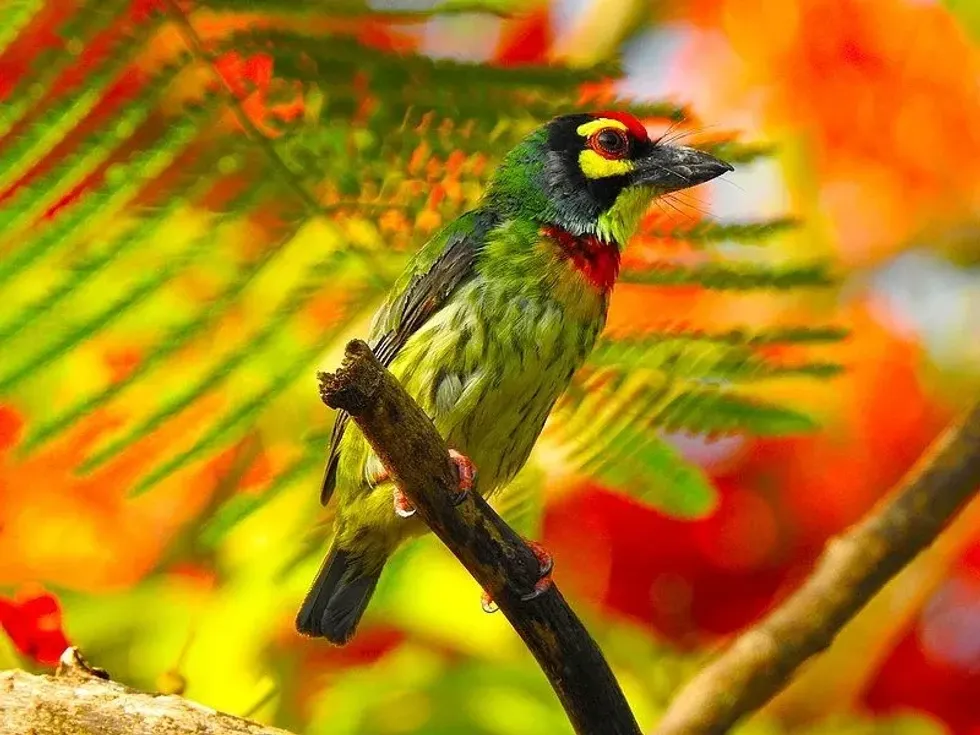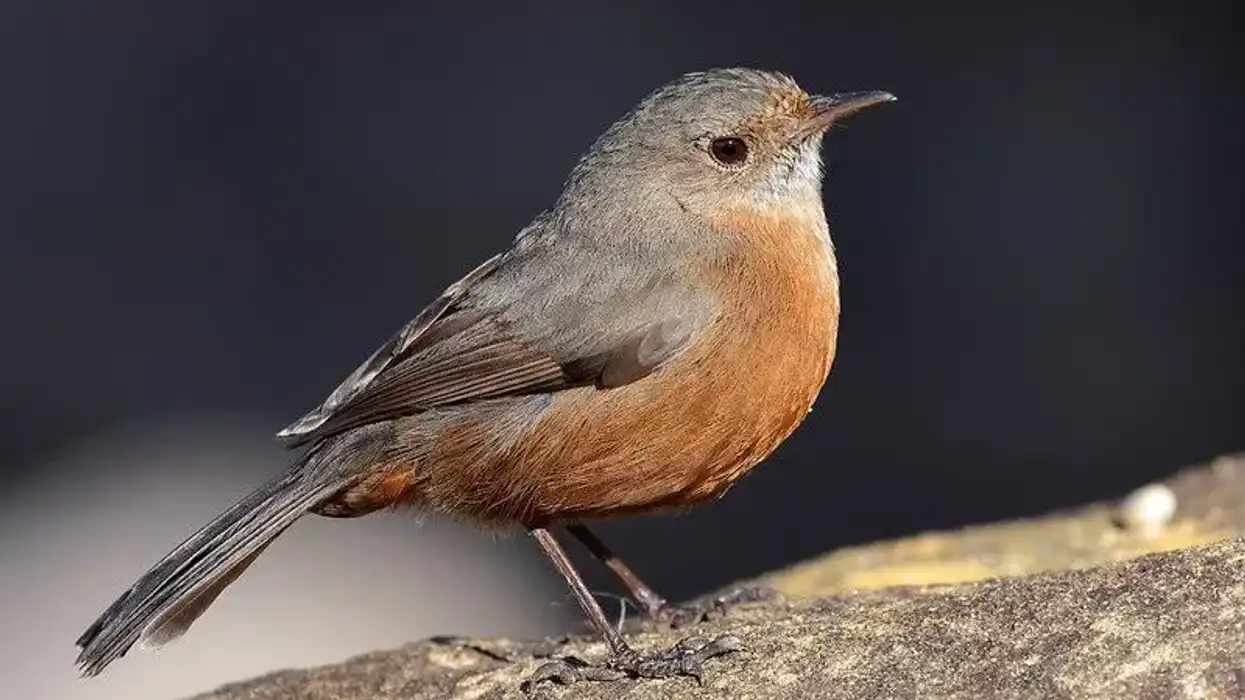If you are a bird lover or are fond of birds then this is the perfect article for you. We present to you the coppersmith barbet (Psilopogon haemacephalus), also known as a crimson-breasted barbet.
This South Asian bird of the Megalaimidae family is very common and owing to the growing steady rise in their population, the coppersmith barbet is a common sight to see in their habitat.
Though the preferred habitat of these birds is open woodlands and forests, these birds can also be found in mountains and hilly areas as well as urban areas.
There are nine known subspecies of the coppersmith barbet. These beautiful birds have green, black, and yellow plumage on their body thereby making them extremely adorable birds.
These barbet birds are omnivorous in nature which means that they consume both plant and animal food. Coppersmith barbet birds feed on small insects and on fruits, nuts, and berries.
As customary in many bird species, ritual feeding is observed among these birds. The coppersmith barbet flight is straight with rapid flaps.
Keep on reading to know more such exciting facts. If you like birds, then you can also find many interesting facts about other bird species, such as the great green macaw and Arctic tern.
Coppersmith Barbet Interesting Facts
What type of animal is a coppersmith barbet?
The coppersmith barbet is a species of small, bright-colored Asian birds that falls under the family of Megalaimidae. They are social animals and often sit next to each other on branches of tall trees in small groups, larger parties, or pairs.
What class of animal does a coppersmith barbet belong to?
The coppersmith barbet, also known as a coppersmith, belongs to the class Aves of the Animalia kingdom.
How many coppersmith barbets are there in the world?
The exact population of coppersmith barbets is not known. However, this crimson-breasted barbet is known to be common throughout its range. The International Union for Conservation of Nature or the IUCN Red List states that their population trend is on the rise.
Where does a coppersmith barbet live?
The coppersmith barbet range map tells us that the bird can mainly be found in South Asia, specifically in Southeast Asia. In India, these birds can be seen living in the Himalayas and Palni Hills in the south.
They are also seen in southwestern Asian countries like Sri Lanka, Pakistan, Nepal, Bangladesh, and southwest China, Malaysia, Sumatra, and the Philippines. Some subspecies have been known to live on islands as well.
What is a coppersmith barbet's habitat?
The preferred habitat of this Southeast Asian bird, coppersmith barbets, is gardens, groves, and open woodlands. Many can be seen living on the outskirts of urban areas and thinned-out forests. However, these birds are mostly found in habitats where there is an availability of dead wood. They use the cavities in them for nesting.
Who do coppersmith barbets live with?
Coppersmith barbets, also known as crimson-breasted barbets, often roost alone in their cavities and usually live in small groups, larger parties, or pairs. Big groups often sit next to each other in branches of tall trees or fly high over treetops.
How long does a coppersmith barbet live?
Not much is known about the exact lifespan of a crimson-breasted barbet. However, we can make a guess based on the other birds in the family Megalaimidae that tend to live for around 10-25 years.
How do they reproduce?
Coppersmith barbets roost much of the year based on different locations of their habitat. In India, the breeding season is between February to April and from December to September in Sri Lanka.
The coppersmith barbet has a distinct mating courtship that involves singing, puffing of the throat, and bobbing of the head by the male bird in the presence of the female.
As common in many species of birds, ritual feeding is also seen in this species of birds. Males are known to put food particles like berries into the mouths of the females.
The pair then finds a perfect tree to build their nest away from the clutches of predators. Double roosting is often noticed by these birds in the Himalayan regions and the female is known to lay around three or four eggs.
However, the eggs are often incubated by both sexes.
Usually, the incubation period is around two weeks where the nesting birds of both sexes protect the eggs from predatory birds. As these birds are double brooded, they are known to brood simultaneously one brood after another.
What is their conservation status?
The conservation status of the coppersmith barbet is Least Concern according to the International Union for Conservation of Nature or the IUCN Red List.
Though details about the exact population of these birds is unknown, their population trend is on the rise which means that their numbers are steadily rising and as of now this species is out of harm from the jaws of extinction.
Coppersmith Barbet Fun Facts
What do coppersmith barbets look like?
Adult coppersmith barbets are brightly colored birds with green bodies and yellowish-green underparts with darker green streaks. It is chubby in size with a short neck and large head with yellow eye-ring and black stripes.
It has a red forehead and red patches in the form of a red throat patch. The presence of a strong and stout bill that is dark in color is used to carve out their nest, preferably inside a tree to avoid attacks from predatory birds and other animals.
Both the sexes of this barbet have little or no variation in their morphology or sizes. Coppersmith barbet juvenile birds are dull green and yellow colored and they don't have red patches like the adults.
How cute are they?
The coppersmith barbet is a very cute bird. Laymen, birdwatchers, and bird enthusiasts usually find this small bird to be extremely adorable.
How do they communicate?
Similar to most birds, the coppersmith barbet communicates via sounds, songs, and calls. The coppersmith barbet song is made up of the 'tuk-tuk' sound which is similar to the sound ofa coppersmith striking metal or a copper sheet with a hammer.
The sound they make it how this bird became known as the coppersmith barbet.
The bird keeps repeating the 'tuk' sound for long periods in low volumes which increases with time and speed, reaching almost 108-121 per minute.
They have a throat patch of bare skin on both sides of their throat which inflates and deflates with each 'tuk' sound they make and their beak remains shut during each call, bobbing their head. These birds don't make noises or sounds when the temperature drops and the coppersmith barbet call remains silent during the winter.
How big is a coppersmith barbet?
The coppersmith barbet is relatively a small-sized nesting bird. They measure 5.9–6.7 in (15–17 cm) in length. When compared to hummingbirds that measure 3-9.1 in (7.6-23 cm), we can say that the coppersmith barbet range is larger in size.
How fast can a coppersmith barbet fly?
The coppersmith barbet flight is straight with rapid flaps. They have a fluttering flight, but their flight speed is still unknown. They are not a migratory bird but can fly within their geographical range
How much does a coppersmith barbet weigh?
The coppersmith barbet weighs almost 1.1 -1.8 oz (30-52.6 g). In comparison to the American kestrel that weighs 2.8-5.8 lb (80-165 g), we can say that the American Kestrel edges pass the former by a slight margin.
What are the male and female names of the species?
The males of this species are called cocks and females are called hens.
What would you call a baby coppersmith barbet?
The baby of a coppersmith barbet is called a chick like other baby birds of any species.
What do they eat?
The coppersmith barbet is mainly frugivorous. They usually eat fruits, banyan, peepal, drupes, flower petals, and berries. It has been seen eating insects like termites caught during flight, and so it is an omnivore.
Are they poisonous?
The coppersmith barbet is neither poisonous nor dangerous.
Would they make a good pet?
The coppersmith barbet is a small nesting bird and lives in nest holes inside a tree. Although they are calm in behavior, it is not suitable to keep them in captivity or as a pet.
Did you know...
The coppersmith barbet is mainly found competing with other nesting birds and frugivore birds present in their region. The blue-throated barbet is often seen taking over the nest holes of the coppersmith barbet. They also have a rivalry with the red-vented bulbul as they keep stealing the berries the barbet brings to the nests for the females.
The barbet roost with their immature newly hatched bird but can prevent them from entering the nest if they return late.
The coppersmith barbet bird is one of the oldest Asian barbets in terms of speciation and some species are kept in aviculture
During the nesting season, the plumage on the upper back of the barbet can appear blueish.
They are cousins to the woodpecker family like the ivory-billed woodpecker, explaining their habit of carving out their nest in the cavity of branches.
How did the coppersmith barbet get its name and what other names does it have?
The metallic 'tuk-tuk' call made by this bird sounds familiar to the 'tuk' sound made when a coppersmith strikes a copper sheet or a metal with a hammer, and so this name is given. It is also called a crimson-breasted barbet due to its appearance of red and yellow patches. Its scientific name is Psilopogon haemacephalus.
Are coppersmith barbets endangered?
The coppersmith barbet is not an endangered species. Their conservative status is of Least Concern, but adult birds are sometimes preyed upon by predatory species.
Here at Kidadl, we have carefully created lots of interesting family-friendly animal facts for everyone to discover! Learn more about some other birds from our rhinoceros hornbill facts and boreal chickadee facts pages.
You can even occupy yourself at home by coloring in one of our free printable coppersmith barbet coloring pages.










